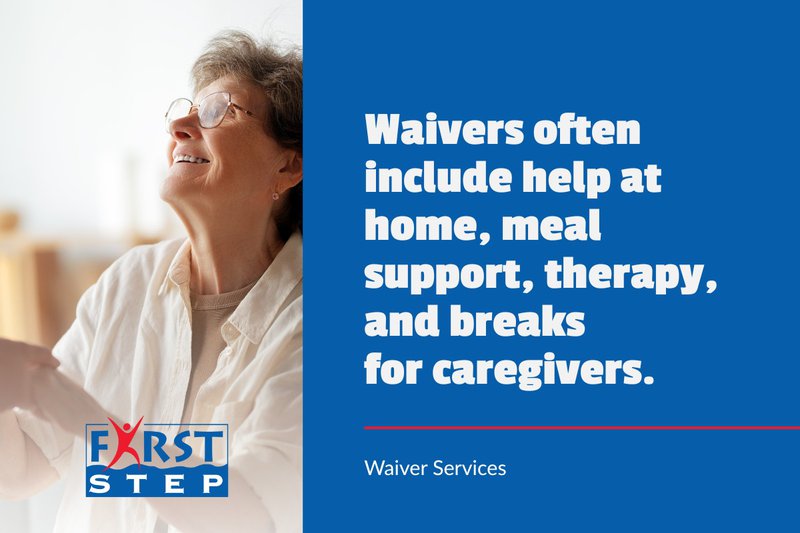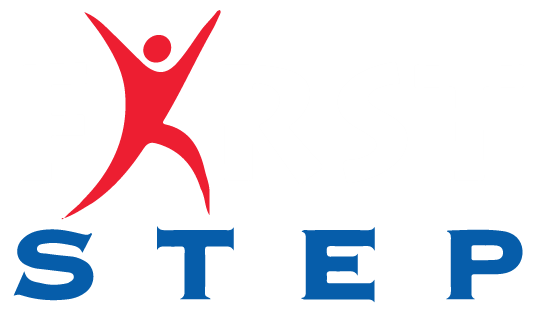Caring for a loved one with disabilities means navigating complex systems while wanting what's best for them. You've heard the term "waiver services," but understanding what they actually cover and how they can help your family feels overwhelming. How do these programs work? What support can your loved one receive at home? When families come to First Step, Inc., these are the questions we answer every day.
Key Takeaways:
- Waiver services allow qualified individuals to receive care at home or in the community instead of institutional settings, promoting independence and quality of life while often reducing costs.
- The 1915(c) waiver is the most common program and provides home and community-based services, including personal care assistance, meal support, therapy services, and respite care for family caregivers.
- Eligibility requires meeting both medical and financial criteria, including low income, demonstrated need for daily assistance, and preference for home or community care over institutional placement.
- Services vary significantly by state and may include job training, home modifications, assistive equipment, and even payment for family caregivers at rates typically ranging from $10–$25 per hour, depending on care level and location.
- The application process involves multiple steps, including gathering medical documentation, completing functional assessments, and working with your state Medicaid office, with approval potentially taking weeks or months.
- Waitlists are common in most states, and understanding your appeal rights and participating in regular reassessments are essential parts of maintaining waiver services.
- Each state designs its own waiver programs with different eligibility rules, service options, and funding limits under federal guidelines.
Understanding Waiver Services and How They Support Your Family
Medicaid waiver services provide a pathway for people with disabilities or chronic conditions to receive care outside of hospitals or nursing homes. The term "waiver" refers to states waiving certain Medicaid rules that typically require institutional care. Instead, individuals can stay in their own homes or live in community settings with appropriate support.
This approach recognizes that institutional care isn't always the best or most cost-effective option. Waiver services deliver care that's just as comprehensive while honoring people's preferences to remain in familiar surroundings with family and community connections intact.
What Makes 1915(c) Waivers Essential for Home-Based Care
The 1915(c) waiver, named after Section 1915(c) of the Social Security Act, is the foundation of home and community-based waiver services. These waivers allow states to design programs that pay for care in homes or small community residences instead of nursing facilities.
Each approved waiver services program creates individualized care plans based on personal needs rather than one-size-fits-all institutional schedules. Services may include assistance with daily activities, professional nursing visits, and scheduled respite periods that give family caregivers necessary breaks.
Common Services Included in Waiver Programs
Waiver services fill critical gaps that standard Medicaid doesn't address. Typical services include:
- Personal care assistance with bathing, dressing, grooming, and eating
- In-home nursing care or visits from trained health aides
- Meal preparation support or delivered meals
- Adult day programs provide socialization and activities
- Durable medical equipment like wheelchairs, walkers, or hospital beds
- Home modifications such as ramps, grab bars, or widened doorways
- Respite care gives family caregivers temporary relief
- Employment support, including job coaching or vocational training
Each state determines which services to offer under its waiver services programs. Some states provide comprehensive home modification benefits, while others focus more heavily on personal care or therapeutic services.
| Service Category | What It Includes | Who Benefits Most |
|---|---|---|
| Personal Care | Help with bathing, dressing, eating, mobility | Individuals needing daily living assistance |
| Respite Care | Temporary relief for family caregivers (hours to days) | Families providing continuous care |
| Home Modifications | Ramps, stair lifts, bathroom safety equipment | People with mobility challenges |
| Behavioral Support | Counseling, therapy, behavior management | Individuals with developmental disabilities or mental health needs |
| Vocational Services | Job training, coaching, supported employment | Adults seeking community employment |
Determining Eligibility for Waiver Services
Qualifying for waiver services requires meeting specific medical and financial criteria that vary by state. Understanding these requirements helps families prepare for the application process.
Medical and Functional Requirements
To receive home and community-based waiver services, individuals must demonstrate they require a level of care typically provided in institutional settings. State representatives conduct functional assessments that evaluate abilities and needs through questions like:
- Can you bathe and dress independently?
- Do you need assistance preparing meals safely?
- Can you manage medications without supervision?
- Do you require help with mobility or transfers?
A healthcare professional, often a nurse or social worker, completes this needs assessment. The evaluation determines the level of care required and whether it matches the institutional level of care that waiver services are designed to replace.
Financial Eligibility Standards
Waiver services operate under Medicaid guidelines, meaning applicants must meet income and asset limits. These thresholds vary by state but generally require that household income falls below established levels. Some states use Supplemental Security Income (SSI) standards as their baseline.
Financial assessments review:
- Monthly income from all sources
- Available assets and resources
- Household size and composition
- Medical expenses that may offset income
State-Specific Variations in Waiver Programs
Every state administers its own waiver services with unique eligibility criteria and service options. Arkansas waiver services help clients with physical or intellectual disabilities to live in the community rather than in an institutional setting
Some waivers target specific populations, seniors only, children with special needs, adults with traumatic brain injuries, or individuals with specific developmental disabilities. Age restrictions, diagnosis requirements, and care setting preferences all influence eligibility.
Applying for Waiver Services: A Step-by-Step Process
Navigating the waiver services application requires organization and patience. Understanding the process helps families prepare and reduces delays.
Initial Steps to Begin Your Application
Start by contacting your state Medicaid office or visiting their website to identify available waiver programs. Each state offers different waivers designed for specific populations and needs. County Medicaid offices can provide guidance on which programs best match your situation.
The application process for home and community-based waiver services includes:
- Determine the appropriate waiver type based on age, diagnosis, and care needs
- Verify preliminary eligibility for both medical necessity and financial requirements
- Gather required documentation, including medical records, income verification, and current care plans
- Complete the formal application with assistance from county staff or case managers
- Participate in functional assessments conducted by state-designated evaluators
- Submit to financial review demonstrating Medicaid eligibility
- Await approval decision, which may include placement on a waiting list
Essential Documentation for Waiver Applications
Thorough documentation strengthens applications and prevents delays. Required materials typically include:
- Recent medical records and diagnoses from treating physicians
- Current medication lists and treatment plans
- Proof of income (pay stubs, benefit statements, tax returns)
- Proof of residence and citizenship or legal status
- Existing care assessments from schools, therapists, or other providers
- Documentation of current care arrangements and needs
A medical professional will complete a formal assessment evaluating your loved one's functional abilities and care requirements. Some states conduct home visits to observe daily living challenges firsthand.
Understanding Approval Timelines and Waitlists
Approval for waiver services doesn't happen overnight. The process often takes weeks or months, depending on your state's current capacity and demand. Many states maintain waitlists when approved slots are filled.
Waitlist duration varies dramatically, from months to years in some states. New openings typically occur when current participants transition out of the program.
County case managers play essential roles throughout this process, coordinating with families, healthcare providers, and schools to compile necessary documentation and facilitate assessments.
Exploring Different Types of Medicaid Waivers
Federal Medicaid law authorizes several waiver types, each serving different purposes within state healthcare systems. Understanding these distinctions helps families identify appropriate programs.
The 1915(c) Home and Community-Based Services Waiver
The 1915(c) waiver is the most widely used for long-term waiver services. It specifically funds home and community-based alternatives to institutional care for people who would otherwise require nursing facility or intermediate care facility placement.
These waivers list specific covered services tailored to help individuals with disabilities or chronic conditions remain in their homes or small community residences. Personal care, respite, day programs, and supportive therapies form the core of most 1915(c) programs.
Comprehensive Services Covered by Waiver Programs
Waiver services encompass a broad range of supports designed to maintain health, safety, and quality of life in home and community settings.
Personal and In-Home Care Services
Core waiver services address daily living needs that many people with disabilities require. Personal care assistants help with bathing, grooming, dressing, toileting, and eating. Homemaker services may include light housekeeping, meal preparation, and errand assistance.
Some states allow family members to become paid caregivers under waiver services programs, providing compensation for the care they're already providing. Professional nursing services bring skilled care into the home for medication management, wound care, or other medical needs.
Therapeutic and Behavioral Supports
Many waiver services programs include therapy and behavioral health services. Children with autism may receive applied behavior analysis or developmental therapies. Adults with mental health conditions can access counseling and psychiatric support. Physical, occupational, and speech therapies help individuals maintain or improve functional abilities.
Vocational services prepare adults for competitive employment through job coaching, skills training, and supported employment programs that provide ongoing workplace assistance.
Respite Care for Family Caregivers
Respite care provides temporary relief for family members providing continuous care. These services may offer a few hours weekly for personal appointments or extended periods for family vacations. Professional caregivers step in so family caregivers can rest, reducing burnout and stress.
Environmental Modifications and Assistive Technology
Waiver services often fund home modifications that improve safety and accessibility. Installation of ramps, grab bars, stair lifts, or bathroom modifications enables people with mobility challenges to navigate their homes safely. Assistive technology, from communication devices to environmental controls, supports greater independence.

Frequently Asked Questions About Waiver Services
How long does it typically take to get approved for waiver services?
Approval timelines vary significantly by state and current program capacity. Initial processing may take several weeks to complete functional and financial assessments. However, many states maintain waitlists, and families may wait months or even years before services begin. During this period, maintaining regular contact with case managers and keeping documentation current can help when openings occur.
Can family members be paid to provide care under waiver services?
Many states allow family caregivers to receive payment through waiver services programs, though specific rules vary. Payment rates typically range from $10 to $25 per hour, depending on the state, care complexity, and whether the caregiver is providing basic personal care or more skilled services. Some states exclude spouses or legal guardians from paid caregiver roles, so checking your state's specific policies is essential.
What happens if my loved one's condition changes after receiving waiver services?
States conduct regular reassessments, typically annually, to evaluate whether care needs have changed. If your loved one's condition improves significantly, services might be reduced. If needs increase, additional services may be authorized. You can also request reassessment at any time if circumstances change significantly. Keeping detailed records of care needs, medical appointments, and daily challenges helps during reassessment periods.
Is there a way to appeal if waiver services are denied or reduced?
Yes. If your application is denied or services are reduced, you have the right to appeal. Most states require appeals within 30 days of the decision. The appeal process typically involves submitting additional documentation from healthcare providers demonstrating medical necessity. You may request a fair hearing where you can present evidence supporting your case. Many families work with social workers or disability advocates during appeals to strengthen their presentations.
Taking Practical Steps Toward Accessing Waiver Services
Getting started with waiver services requires planning and persistence, but breaking the process into manageable steps makes it less overwhelming.
Step 1: Research Your State's Available Programs (Week 1-2)
Visit your state Medicaid website or contact your local Medicaid office to identify which waiver services programs operate in your area. Make a list of programs that match your loved one's age, diagnosis, and care needs. Request information packets and application materials. If possible, connect with other families already receiving services to learn from their experiences.
Step 2: Gather Documentation and Complete Assessments (Week 3-8)
Collect medical records, diagnostic reports, and current treatment plans from all healthcare providers. Obtain letters from doctors explaining why home-based care is appropriate and necessary. Compile financial documents, including income verification and asset information. Schedule and complete required functional assessments with state evaluators. This preparation phase takes time but strengthens your application significantly.
Step 3: Submit Application and Maintain Communication (Week 9+)
Submit your complete application with all supporting documentation. Keep copies of everything you submit. Establish regular contact with your assigned case manager, checking in monthly for status updates. If placed on a waitlist, ask about your position and estimated wait time. Continue documenting your loved one's care needs during the waiting period, as this information supports future reassessments.
Expert Waiver Services Support at First Step, Inc.
At First Step, Inc., we understand that navigating waiver services can feel overwhelming when you're already managing complex care responsibilities. Our team specializes in helping families access the home and community-based supports their loved ones need to thrive.
We take a personalized approach to every family we serve, recognizing that each person's needs, strengths, and goals are unique. Our evidence-based practices ensure you receive accurate information about available waiver services, while our collaborative approach means we work alongside you, not just for you.
Whether you're just beginning to explore waiver services options or need support managing existing services, First Step, Inc. provides compassionate guidance through every step. We help families understand eligibility requirements, prepare applications, navigate waitlists, and advocate during reassessments or appeals.
Your loved one deserves care that honors their dignity and supports their independence. We're here to help make that possible. Contact First Step, Inc. today to learn how waiver services can transform care for your family.


